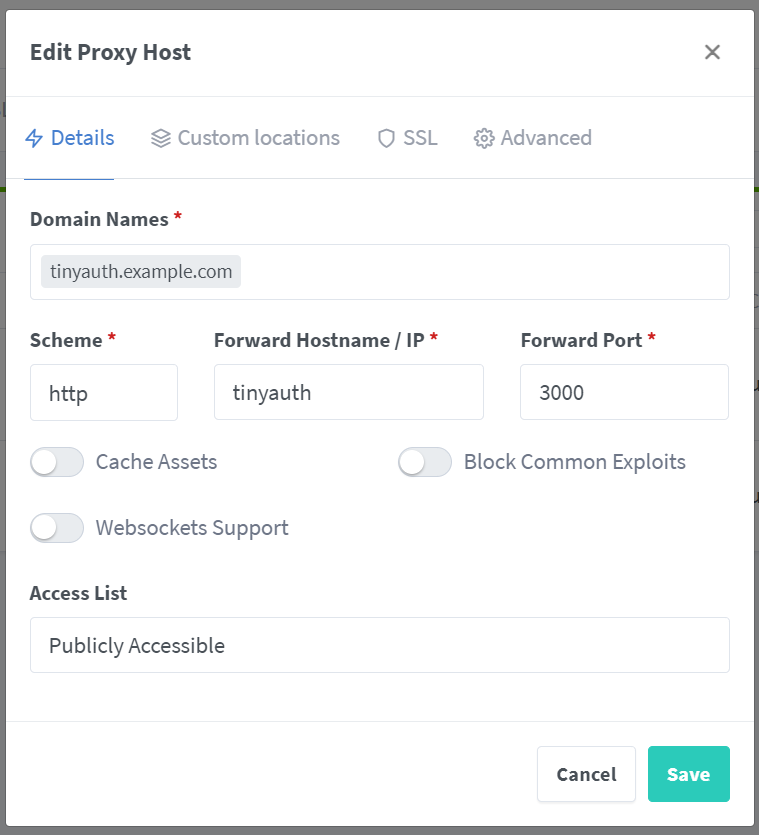Nginx Proxy Manager
Use Tinyauth with the Nginx Proxy Manager reverse proxy.
Nginx Proxy Manager is a popular tool in the homelab community for managing reverse proxies. While it differs from Traefik and Caddy due to Nginx's lack of native 302 redirect support in the auth_request module, Tinyauth provides API paths specifically designed to work with it.
This guide assumes familiarity with Nginx Proxy Manager.
Example Docker Compose File
The following Docker Compose file demonstrates how to set up Nginx Proxy Manager, Nginx, and Tinyauth:
services:
npm:
container_name: npm
image: jc21/nginx-proxy-manager:2
restart: unless-stopped
ports:
- 80:80
- 443:443
- 81:81
volumes:
- npm-data:/data
- npm-letsencrypt:/etc/letsencrypt
nginx:
container_name: nginx
image: nginx:latest
restart: unless-stopped
tinyauth:
container_name: tinyauth
image: ghcr.io/steveiliop56/tinyauth:v4
restart: unless-stopped
environment:
- APP_URL=http://tinyauth.example.com
- USERS=user:$$2a$$10$$UdLYoJ5lgPsC0RKqYH/jMua7zIn0g9kPqWmhYayJYLaZQ/FTmH2/u # user:password
volumes:
npm-data:
npm-letsencrypt:OAuth and access controls can be configured using Docker labels and environment variables. All other configurations are managed through the Nginx Proxy Manager UI.
Configuring Nginx Proxy Manager
Creating the Tinyauth Host
Create a host for Tinyauth in Nginx Proxy Manager. Configure it as any other host:

SSL can be set up if certificates are available.
Ensure the "Block Common Exploits" option is disabled. If enabled, Nginx will block URLs in query parameters, which are required for Tinyauth to function.
Configuring Protected Hosts
For protected hosts, such as Nginx, configure the Details tab similarly to the Tinyauth host:

SSL can be configured as needed.
The "Block Common Exploits" option can remain enabled for protected hosts.
Advanced Configuration
Add the following configuration in the Advanced tab to enable Tinyauth authentication:
# Root location
location / {
# Pass the request to the app
proxy_pass $forward_scheme://$server:$port;
# Add other app-specific config here
# Tinyauth auth request
auth_request /tinyauth;
error_page 401 = @tinyauth_login;
}
# Tinyauth auth request
location /tinyauth {
# Pass request to Tinyauth
proxy_pass http://tinyauth:3000/api/auth/nginx;
# Pass the request headers
proxy_set_header x-forwarded-proto $scheme;
proxy_set_header x-forwarded-host $http_host;
proxy_set_header x-forwarded-uri $request_uri;
}
# Tinyauth login redirect
location @tinyauth_login {
return 302 http://tinyauth.example.com/login?redirect_uri=$scheme://$http_host$request_uri; # Replace with your app URL
}The /tinyauth path can be renamed for convenience.
Additional configuration may be required under the / location for
technologies like WebSockets.
Save the host configuration. Accessing the protected host will redirect to the Tinyauth login page if not already logged in. Repeat this process for each host to be protected by Tinyauth.